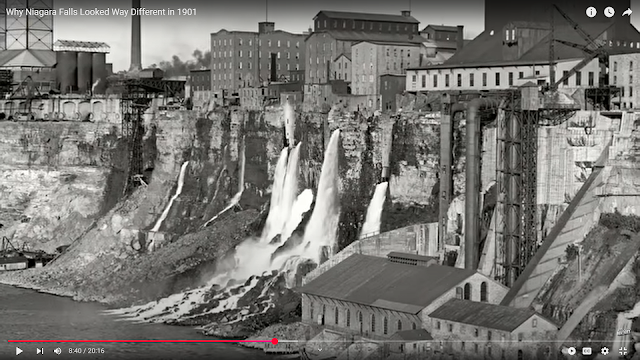(
Satellite)
Before electricity was developed, the Niagara Gorge was lined with water-driven mills. After electric power was developed, the mills were replaced by the
Schoellkopf Power Station.
 |
𝗥𝗲𝗺𝗲𝗺𝗯𝗲𝗿 𝗪𝗵𝗲𝗻: 𝗡𝗲𝘄 𝗝𝗲𝗿𝘀𝗲𝘆 & 𝗡𝗲𝘄 𝗬𝗼𝗿𝗸 posted
Step Back in Time to Niagara Falls, New York, 1906!! |
Matt Pyle
posted seven photos with the comment:
=Turbine Topic=
For this installment of Turbine Topics, we head northwest from NJ and turn our view to NY and the site of the Niagara Falls Power & Manufacturing Company. After digging into the topic this will be a 2-part article due to the immense variety of hydraulic activity at the site. [Part 2 is in
Schoellkopt Power Station.] But we will start where we always do, the beginning. The first commercial use of the Niagara River dates clear back to a small sawmill that began operation in 1725, but it was years later in 1847 when large scale hydraulic industry finally took root. The vision of a grand canal was planned by Augustus Porter in 1847, though the original plans were outlined loosely prior in 1842. With much anticipation construction finally began in 1853 with construction activities taking a total of approximately sixteen months. Upon completion the newly constructed canal system measured approximately 35' wide and 8' deep, extending 4,500’ in length. The canals inlet was located just above goat island on the Niagara River and cut through the city with its termination and discharge being a steep cliff just north of the American side of Niagara Falls.
Though the capacity for industry was ready and available, the canal stayed relatively dormant for a number of years. In 1875 the canal works was sold to the ambitious Jacob Schoellkopf, a prominent NY businessman of the times. Under the direction of Mr. Schoellkopf industry on the canal finally started to take off and a wide variety of industrial mills were constructed and drawing water for mechanical power from the canal. As industry grew so did the need for increased hydraulic capacity. The current system as built had reached full capacity at this point, with a total of 14 turbines in operation powering the industries of the mill district. Plans were drawn up and the canal was expanded with the intent of occupying the entire 100' width of the property easement for increased capacity. This increase of 70' in width would bring a world of potential to the local area.
This volume of raw power was a bit of a learning curve for the early waterpower users. Historical articles reference a great amount of trial and error, including quite a number of references to wooden water wheels that were not up to the task of operating successfully under the high head of the canal. But as turbines were introduced and technology and engineering improved more power and higher efficiencies were realized from the system. Historical references also state multiple instances of change and growth through the years with many mills progressively operating under high and higher amounts of effective head and water volume. These improvements set the stage for the electrical generation wonders that lie just ahead.
Commentary:
Pictured below is the sanborn fire insurance map of the mill district from 1892. Spread throughout the mill district is a variety of industries and facilities than can be examined more closely by following the link below.
Matt Pyle
shared with the comment: "Repost from the SMS group here on the east coast."
 |
| 1 |
 |
| 2 |
 |
| 3 |
 |
| 4 |
 |
| 5 |
 |
| 6 |
 |
| 7 |
At
7:30 the video starts talking about the industrial revolution and water power.
The video shows this image for 1759.










No comments:
Post a Comment